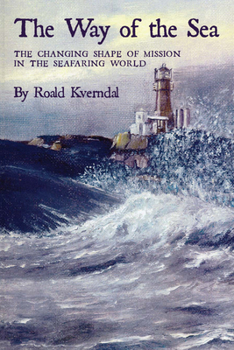Way of the Sea
The Changing Shape of Mission in the Seafaring World
The sea has been both a source of bounty and a bridge of communication through the ages. The Way of the Sea explores the unique role of seafarers in promoting the revealed plan of the Creator and Redeemer of both land and sea.
As a follow-up to The Seamen's Mission, Kverndal's comprehensive survey of maritime mission presents both historical and current perspectives. While The Way of the Sea provides a much-needed tool for the developing field of maritime Missiology, people from all walks of life will learn from the rich history and culture of kingdom-minded seafarers.
The sea has been both a source of bounty and a bridge of communication through the ages. The Way of the Sea explores the unique role of seafarers in promoting the revealed plan of the Creator and Redeemer of both land and sea.
As a follow-up to The Seamen's Mission, Kverndal's comprehensive survey of maritime mission presents both historical and current perspectives. While The Way of the Sea provides a much-needed tool for the developing field of maritime Missiology, people from all walks of life will learn from the rich history and culture of kingdom-minded seafarers.
Format:Paperback
Language:English
ISBN:0878083669
ISBN13:9780878083664
Release Date:January 2008
Publisher:William Carey Publishing
Length:456 Pages
Weight:1.40 lbs.
Dimensions:0.9" x 6.0" x 9.0"
Customer Reviews
1 rating
An oft forgotten area in Missiology
Published by Thriftbooks.com User , 15 years ago
TiTLE: "An oft forgotten area in Missiology." TAGS: sea, seafarer, maritime, shipping, exploitation, greed, FOC, unions, mission, church, globalization, pluralism, universal, great commission FULL REFERENCE: Kverndal, Roald, "The Way of the Sea: The Changing Shape of Mission in the Seafaring World." Pasadena, CA: William Carey Library Publishers, 2008. ////// Kverndal's 422-page volume is an eye opener in several senses of the word: it opened my eyes {as it may open the eyes and minds of other readers and missiologists in particular} to... 1) the forgotten dimension of missiology! Even though i graduated with a Ph.D. in Missiology {Mission Theology} from Fuller Theological Seminary in 2002, it never crossed my mind that a particular "mission in the seafaring world" even existed, let alone the challenges and rewards it is facing on a daily basis. 2) the challenges and rewards that "mission in the seafaring world" is facing on a daily basis. Among these challenges, the increasing difficulty of gaining access to ships for shipvisiting purposes during the ever-shorter turn-around time of transoceanic shipping practices, and the post "911" limitations imposed on crews' freedom of movement between the confines of the "total institution" that represents their merchant ship, and the attractions of the port of call. 3) Last, but not least, to the dim reality of the lives of seafaring workers, often hired under fraudulent contracts {which they may or may NOT be able to read and understand as it may NOT be written in their native language, such as Hindi, Nepali, or Arabic}, and often living in substandard housing conditions, and eating substandard food, and drinking substandard water, as unscrupulous shipmasters try to "cut corners" whenever and wherever they can, and get away with it, especially under the system of adopting a FOC ("flag of convenience"), i.e., the flag of a country other than the country of origin/registration, because the country of origin/registration may have more stringent rules and regulations about services to be provided to the crew. In Part i (One) of this well-documented book, Kverndal retraces the history of maritime mission, dividing into three sections: 1) Early/premodern era (until 1920); 2) Ecumenical/modern era (1920-1974); and 3) the global/postmodern era (from 1974 to the present day, or at least until the year of the book's publication in 2008). In Part ii (Two), we find an overview of maritime mission, both its theoretical foundations (Chapter 13); and its practical aspects (Chapter 14). Finally in Part iii (Three), we find no less than 31 (thirty-one) short (3-4 pages) articles and essays from various authors writing about various perspectives about maritime mission. Among these authors, we find well-known names in missiology, such as Miriam Adeney (pp. 273); the late Paul Hiebert (pp. 315-318); and other well-known names such as South Africa's Bishop Desmond Tutu writing about "truth and reconciliation" (pp. 385





